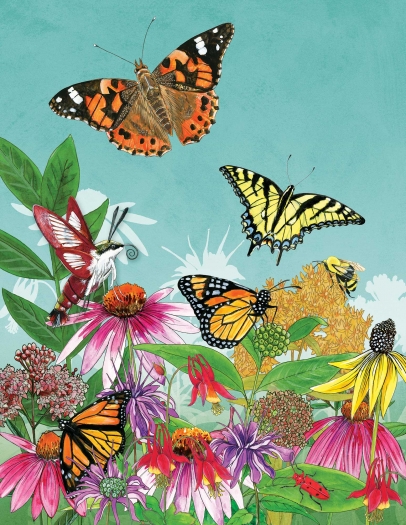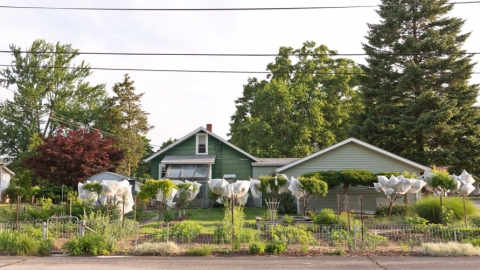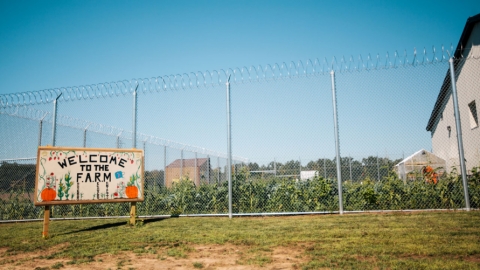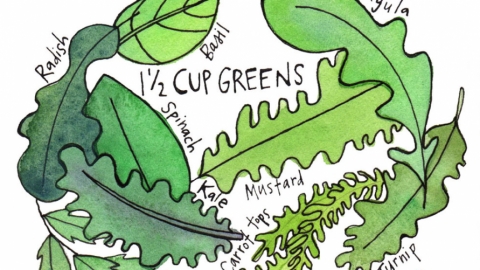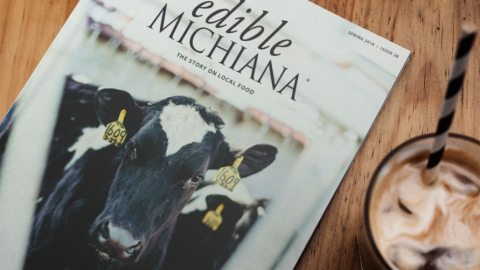Pollinator gardens: beauty, function and flourishing
I take in the slow pumping of burnt orange and black wings against lavender thistle blossoms with my daughters, listening to the audible in-breath of their wonder. From the side, we watch the monarch’s proboscis—the long, straw-like organ this butterfly uses to drink nectar—bounce methodically around the flower.
“It’s so good to see Monarchy here again,” whispers 8-year-old Emmy without lifting her gaze from the creature.
“Monarchy” is Emmy’s name for every monarch—including herself when she dons fabric wings—but especially the “one” that visits the field downhill from our house. We designed the pollinator space together, and the upkeep is simple enough. I leave the majority of the field to grow feral, and mow four spiraling paths that we use to explore. This laissez-faire approach provides a good deal of habitat for pollinators and other life.
We continue along the path toward a patch of common milkweed. “Look at that red bug!” says 4-year-old Evelyn as she points to a bittersweet-colored beetle on a broad leaf and brings her face within inches.
“These milkweed beetles eat this plant like monarch caterpillars. They all need food, just like we do, so that’s why we let all these plants grow in the field,” I explain. She nods, then runs on to chase a yellow butterfly with her sister.
One way to continue toward healthy, resilient, diverse local food systems is to create spaces for pollinators, people and wildlife to thrive.
Pollinators and our food
While pollinators can be a source of wonder and existential beauty and fulfill an important role in natural communities, they are also connected with our diets. According to the Food and Agriculture Organization of the United Nations, more than 75% of the world’s food crops depend on the work of pollinators in part of their life cycle.
Domestic honeybees and monarch butterflies are some of the pollinators that have caught society’s attention, but there is an incredible amount of biodiversity among pollinators. For example, globally there are more than 20,000 species of wild bees, each doing important work by pollinating plants to keep life moving. Locally, the large, fuzzy-looking bumblebees and several species of small, brightly colored bees are distributing pollen as much as any other species. The hummingbird moth, eastern tiger swallowtail and ruby-throated hummingbird are other favorite local pollinators that play a part in our food systems.
Landscaping for pollinators
We can create spaces that provide food and habitat for pollinators without a lot of extra work. Jay Rozelle, owner of Rozelle Lawn and Landscape in Fort Wayne, IN, and a masters student in Environmental Education at Goshen College, offers several recommendations to create habitat for pollinators through landscaping choices.
“I like to plant butterfly weed as much as possible. This milkweed has a tight profile, it flowers for a long time, and the blossoms are a bright orange that contrasts nicely with other ornamental native plants like purple coneflower or gray-headed coneflower,” he says.
“And if decorative grasses like prairie dropseed, switchgrass and little bluestem are planted with these pollinator-friendly species, it looks great and provides habitat for caterpillars and other larvae, too.”
Space for pollinators in Michiana neighborhoods
Carol Good-Elliott, environmental educator and ornithologist at Merry Lea Environmental Learning Center, has been creating habitat for pollinators in her yard in downtown Goshen for 18 years. When asked which part of her yard is her pollinator garden, she glances toward the ceiling for a second and says, “The backyard, front yard and both side yards have native plants that pollinators use—so I guess all of it.”
In the front yard, New England asters, bee balm and butterfly milkweed provide a more manicured look. In the side yard, thinned stands of goldenrod create habitat; in the backyard, common milkweed. The goldenrod and common milkweed grew on their own. Carol cuts back the goldenrod plants just before the land greens and buries the milkweed’s seeds, though they spread mostly from clones that grow from their roots.
Other steps we can take
Aaron Sawatsky Kingsley, Goshen’s director of environmental resilience, keeps honeybees at his home north of town. Caring for honeybees, as one might expect, can change your perspective on how pollinators live and how landscaping decisions affect food availability.
“One of the things I’ve learned while watching my bees is that they rely on dandelions early and late in the season. So, one thing we could all do to help pollinators is allow the dandelions to grow instead of removing them from our yards,” he says.
Aaron also suggests planting flowering trees. Basswood, redbud, dogwood and northern catalpa trees flower beautifully and provide valuable shade to helpkeep our homes cool in the summer and retain storm water, among other benefits.
Beauty, function and flourishing
From the swirls in the field, the girls chase the yellow butterfly—a clouded sulphur named Flutterist—uphill to the row of lavender plants that line the front porch. Bumblebees, honeybees, many more “Flutterists” and painted ladies feast on the nectar made by flowers that we will use later in soaps and desserts, bundle as gifts, and stash on dashboards to enliven the inside of our vehicles. They become part of our family life.
As it often works, when we create space for the diversity of life, the land reciprocates with beauty, ecological function and food for pollinators and people, alike.
More information
How-to and resources for planting native lawns and gardens:
pollinators.msu.edu/resources/pollinator-planting
List of Indiana native plants for pollinators:
extension.entm.purdue.edu/publications/POL-6/POL-6.pdf
List of Michigan native plants for pollinators:
michigan.gov/documents/dnr/mi_pollinator_gardening_tips_615821_7.pdf
Sources for Michigan native plants and seeds:
mnppa.org/members.html
Native plant nurseries and other resources:
heinzetrust.org/resources.html
Native milkweed seed finder:
xerces.org/milkweed/milkweed-seed-finder#search
Native landscape society with local chapters, grants, certifications, etc.:
wildones.org


